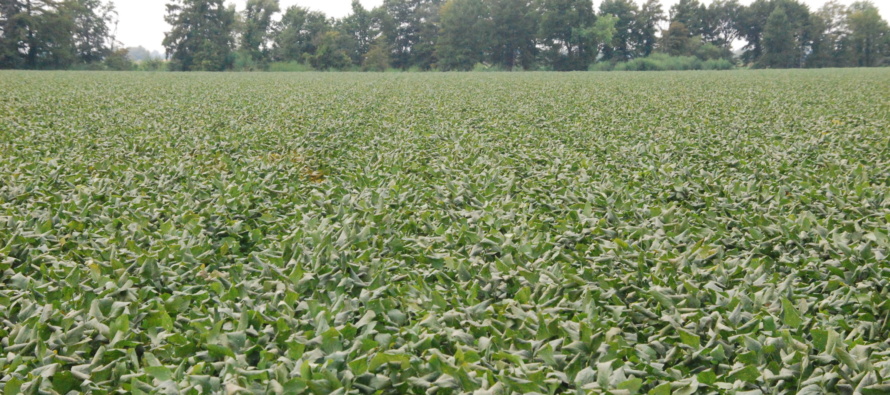Considering an R3/R4 Automatic Fungicide Application in Soybean?

Related Articles
- 2010 Soybean And Corn Variety Trial Data 3
- Rice Variety Trial Results For 2010, Plus Rice Research Report 0
- Evaluation of Peanut Prescription Rx Program in Mississippi 0
Latest Tweets
 For the better part of a decade soybean farmers have benefited from making an automatic fungicide application to soybean fields somewhere between the R3 and R4 growth stages. Many of the specific questions from the past two weeks can be addressed based on the information as outlined below.
For the better part of a decade soybean farmers have benefited from making an automatic fungicide application to soybean fields somewhere between the R3 and R4 growth stages. Many of the specific questions from the past two weeks can be addressed based on the information as outlined below.
Should I spray every field at R3/R4 with a fungicide?
Short answer is no. Over the past 15 years, dryland fields have not produced near the benefit from an automatic fungicide application. More specifically, or the long answer: field situations that have been more commonly dubbed “high-yield scenarios” likely benefit the most from an automatic fungicide application. A high-yield scenario is generally considered to be: continuous soybean (a double-crop situation is NOT a continuous soybean situation or a situation where you rotate for a season out of soybean), early planted, and in an irrigated environment is more commonly referred to as a high-yield scenario.
What is the best fungicide product to apply?
If you are only planning on making an automatic fungicide application, and more specifically to a soybean variety with a good disease package, then specific product choice is not important. Over the past two weeks we have fielded multiple calls regarding “what’s the best fungicide product to apply to soybean?”. Many years ago, a stand-alone strobilurin (or QoI) fungicide was the best choice. However, over the past three seasons it has been determined that a fungicide containing at least two modes of action is more beneficial at R3/R4. Large plot fungicide trials have been conducted for the past three seasons. We will stay away from naming the specific product, but they are the commonly applied and commercially available pre-mix fungicide products. Averaged over three years, an automatic fungicide application made with a product containing multiple modes of action accounted for 69.5 bu/A while a single mode of action strobilurin application accounted for 68.3 bu/A. The nontreated accounted for 65.1 bu/A. the average of the data set suggests that a stand-alone strobilurin fungicide application may not be as beneficial as in the past due to the likelihood of fungicide resistance within the soybean pathogen population (e.g., target spot).
What is the best application timing?
Oftentimes the statement is made “well, it is so hot and dry now there are not any diseases present so I will wait to make the application”. Expectations as a result of the fungicide application are not made on the prevailing current environment. The ultimate expectation will be met several weeks down the road. None of us know what the environment (or weather) is going to look like in a month. The greater data set generated since the early 2000s suggests that an application made between R3 and R4 is the most beneficial based on yield post-application. However, that same data set suggests the application results in a positive return on investment approximately 60% of the time.
Can I use the same product to manage a disease?
Honestly, this is a loaded question. At this point in the year the specific foliar diseases present in our production system are not only at low levels, but not threatening yield. Only time will tell what the environment does. We have already started to receive calls regarding target spot management. While we realize that target spot was the major disease that occurred in 2016 and 2017, the main ingredient in those two seasons tended to be rain at specific growth stages (R4 and beyond). Making a fungicide application to prevent target spot in a season where it might not be an issue is not economically feasible and it does nothing to protect against the disease if the environment is not conducive for disease development. Several Farm Press outlets have had full page advertisements regarding target spot management. Timing a fungicide application to manage target spot would be incredibly difficult. Over the past two seasons we have had application timings at R3, R4 and well into R5. Even following those fungicide applications, and more specifically, regardless of product, target spot was still observed and defoliation as a result of target spot was still present. Yes, some specific fungicides did reduce the observable defoliation that resulted from target spot; however, the yield benefits that resulted from a fungicide application in small-plot trials conducted in Stoneville, MS on a target spot-susceptible variety ranged from 1 to 4.9 bu/A. Defoliation in the same small plot trials on average by treatment ranged from a low of 54% to a high of 66%. Even though some specific fungicides did reduce the observable defoliation (as rated 47 days post-application), defoliation was still observed regardless of specific product or mode of action. No fungicide should be expected to eradicate the disease once applied. Moreover, a fungicide application will not keep every leaf on a plant.
Should I make an insecticide application at the same time?
for information regarding the need for an insecticide application when insects are not present or below threshold.




Let me tell You a sad story ! There are no comments yet, but You can be first one to comment this article.
Write a comment